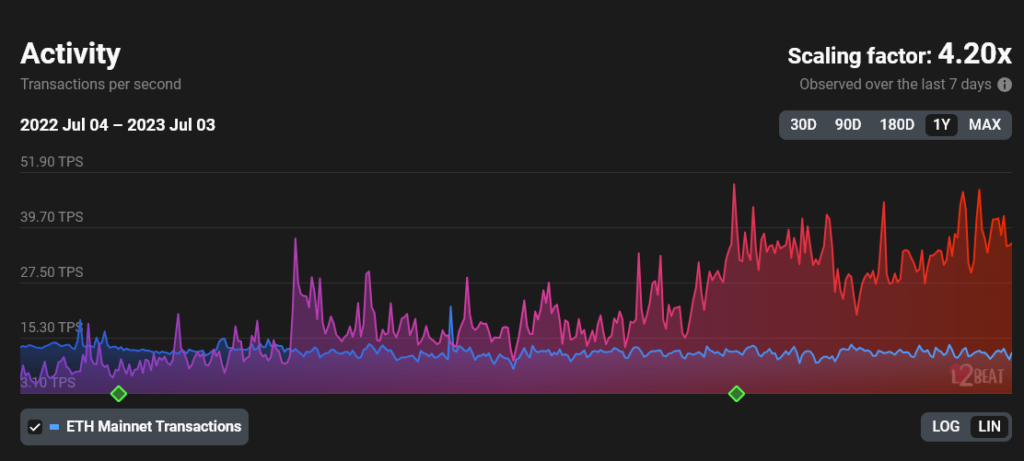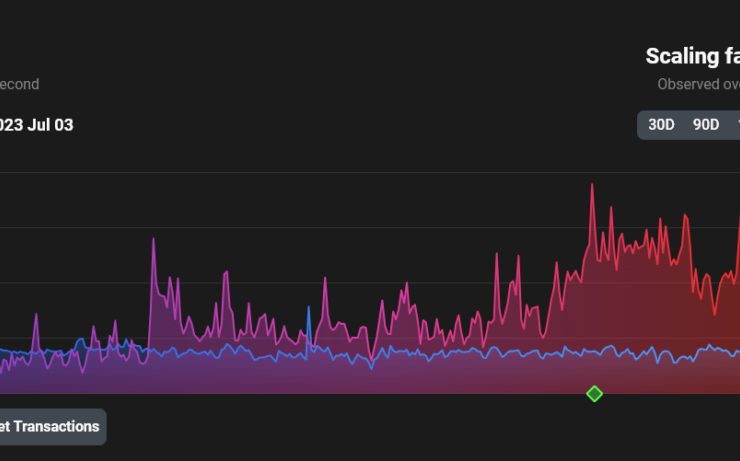The landscape of blockchain scalability has evolved significantly in recent years, with Layer-2s (L2s) and sharding emerging as the two dominant approaches.
Ethereum, a key player in the crypto industry, has adopted rollup-centric L2s to scale its network, while NEAR protocol has taken a different path, choosing to scale via sharding. Both strategies offer unique solutions to blockchain scalability, but they also present their distinctive challenges.
Ethereum’s Layer 2s: A Rollup-Centric Approach
NEARWEEK, a NEAR protocol publication, commended Ethereum for garnering considerable attention for its innovative rollup-centric scaling strategy. An L2 protocol is built atop an existing blockchain to enhance scalability, throughput, and privacy. This is achieved by executing state transitions off-chain from the Layer-1 (L1) they’re built upon and committing state roots and transactional data to the underlying L1.
NEAR sees the driving philosophy behind rollups as the belief that a rollup can outperform the underlying L1 in terms of throughput due to decreased consensus overhead. However, in practice, NEAR believes the overall scaling achieved by rollups collectively has been somewhat disappointing, barely surpassing what a single rollup can offer.
However, data from L2 analysis platform L2Beat offers a contrasting view due to increased L2 activity over the past year, as shown in the chart below.


Further, reviewing the top 10 Ethereum L2s shows Arbitrum One and zkSync Era closing in on Ethereum’s monthly transaction count. Additionally, Immutable X and Arbitrum Nova have surpassed Ethereum’s growth in average transactions per second (TPS) over seven days. Notably, Ethereum had a higher active TPS than any L2 scaling solution on the network on July 3.
| # | Name | Past Day TPS | 7D Change | Max Daily TPS | 30D Count | Data Source |
|---|---|---|---|---|---|---|
| 1 | Ethereum | 12.29 | 6.48% | 22.37 (2022 Dec 09) | 31.45 M | Blockchain RPC |
| 2 | Arbitrum One | 9.69 | -4.17% | 31.64 (2023 Mar 23) | 24.81 M | Blockchain RPC |
| 3 | zkSync Era | 8.63 | -14.74% | 12.00 (2023 May 16) | 22.27 M | Blockchain RPC |
| 4 | OP Mainnet | 6.00 | -12.97% | 9.26 (2023 Jan 12) | 14.82 M | Blockchain RPC |
| 5 | dYdX | 3.09 | -38.54% | 11.45 (2022 Feb 15) | 9.42 M | Closed API |
| 6 | Immutable X | 2.01 | 7.47% | 39.35 (2022 Mar 11) | 5.67 M | Closed API |
| 7 | Starknet | 1.79 | -9.17% | 3.05 (2023 May 16) | 4.61 M | Explorer API |
| 8 | Arbitrum Nova | 1.34 | 18.15% | 10.93 (2023 Apr 27) | 2.99 M | Blockchain RPC |
| 9 | ApeX | 0.95 | 2.27% | 1.38 (2023 Apr 13) | 2.68 M | Closed API |
| 10 | zkSync Lite | 0.89 | -27.20% | 3.29 (2023 Mar 21) | 2.52 M | Explorer API |
| 11 | Polygon zkEVM | 0.64 | -5.13% | 0.82 (2023 Jun 13) | 1.34 M | Blockchain RPC |
Data from L2Beat.com
However, the primary cause of NEAR’s suggested lackluster performance is attributed to the fact that popular Ethereum decentralized applications (dApps) operate on nearly all rollups, resulting in similar transactions being ‘duplicated’ across different rollups.
NEAR’s Shard-Centric Approach
NEAR Protocol has, conversely, opted to tackle scalability through sharding, which partitions the network into distinct segments built directly into the protocol. According to NEARWEEK, each shard in NEAR’s architecture can be likened to an optimistic rollup in Ethereum’s approach.
The key advantage of NEAR’s sharding approach lies in its composability, which allows applications on one shard to interact with applications on another shard natively. This homogeneous sharding model allows applications to interact in the same way regardless if they’re deployed on the same shard, relieving developers from deciding which shard to deploy their applications.
Additionally, NEAR’s sharding model offers faster transaction finality, typically within two to three seconds, outperforming the extended finality times in the rollup universe.
While NEAR Protocol does not list its real-time TPS on the block explorer, it can be calculated based on data from the most recent blocks. A CryptoSlate analysis of transactions from the NEAR block explorer showed an average TPS of roughly 5.7 transactions per second on July 4. This snapshot of NEAR’s TPS aligns with the top five L2s on the Ethereum network. The NEAR community foresees the protocol’s potential through sharding will reach 100,000 TPS in the future.
Contrasting Design Philosophies
The different scaling approaches adopted by Ethereum and NEAR highlight their contrasting design philosophies. While Ethereum prioritizes resilience, maintaining a simple L1 protocol design, NEARWEEK stated NEAR Protocol leans towards a simplified user experience, taking on additional protocol complexity to ensure a superior UX.
Furthermore, it’s important to note that NEAR is not aiming to be “just an L1” as it seeks to function as a Blockchain Operating System (BOS), providing a universal layer for navigating and discovering open web experiences. Through the BOS, NEAR aims to
“empower developers and users from various blockchains, including Ethereum Layer 2s, to construct and utilise applications across a multitude of blockchain ecosystems.”
More details on NEAR’s BOS vision can be found on its Medium account.
Blockchain scalability remains a complex and crucial issue in the crypto world. As Ethereum’s rollup-centric L2s and NEAR’s sharding evolve, it will be intriguing to see which approach proves most effective in the long run.























Comments (No)